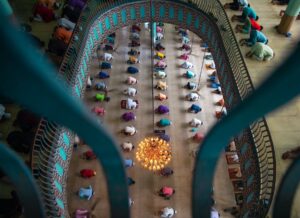For those living in or visiting Şırnak, it’s crucial to know the Şırnak Ezan Saatleri (call to prayer times). This picturesque city, nestled in Turkey’s southeastern region, is home to a deeply religious community. Knowing the prayer times not only allows for spiritual observance but also helps in planning daily activities.
The Şırnak Ezan Saatleri rings out five times a day, marking the Islamic prayer times. Each prayer has a specific time, which shifts slightly throughout the year based on the lunar calendar. It’s a rhythm that shapes the day-to-day life in Şırnak, blending the spiritual with the mundane.
Understanding the Şırnak Ezan Saatleri can seem complicated, especially for visitors or new residents. But don’t worry – we’ll guide you through it, ensuring you’re always in sync with Şırnak’s unique rhythm. Whether you’re a devout Muslim or a curious traveler, this information is essential.
Şırnak Ezan Saatleri
In the daily lives of Şırnak’s residents, the Şırnak Ezan Saatleri holds immense value. Not only does it signal the times for spiritual observance, but it also serves as an essential cornerstone around which they anchor their daily activities.

This integral role of Şırnak Ezan Saatleri is hardly surprising. With the ezan ringing out five times a day, the call to prayer neatly divides the day into blocks of time. Be it morning routines or evening contemplations; the residents invariably tune their lives to this unique rhythm.
It’s not just about preserving rich cultural traditions; it’s also about operational practicality. By adhering to the Şırnak Ezan Saatleri, the residents can efficiently manage and plan their daily activities. This organized approach facilitates smoother transactions and interpersonal interactions, greatly contributing to the overall productivity of the community.
Each of the five prayer times denoted by the ezan holds a distinct significance. The shifting times, based on the lunar calendar, keep them in sync with nature’s cycle.

But what about visitors or those who’ve newly settled in Şırnak? Well, understanding the Şırnak Ezan Saatleri can appear challenging initially. But don’t worry. Much like any tune, it’s only a matter of time before they too sync up with the city’s intrinsic rhythm.
Next up, let’s explore the intricacies around these shifting prayer times and delve deeper into the lunar calendar’s role. Secure in this knowledge, adapting to life in Şırnak will become a more accessible feat.
The Five Daily Prayer Times In Şırnak
In Şırnak, the call to prayer, or Şırnak Ezan Saatleri, rings out five times a day. Each of these prayer times known as Salat carry specific meaning and hold sacred significance in the Islamic faith.

- Fajr is the pre-dawn prayer performed before sunrise. It acts as a preparation for the forthcoming day, where residents search for spiritual guidance and clarity. Fajr imbues not only a sense of peace but also disciplines the circadian rhythm, setting the pace for a harmonious day ahead.
- Dhuhr, the noon prayer, comes post-zenith at midday. It’s a timely reminder for residents in the midst of daily activities, bringing a pause for spiritual reconnection, introspection, and rejuvenation.
- The afternoon prayer, Asr, arrives in the afternoon. Asr serves as a timely reminder for the faithful, amidst the routine chores and work, to seek spiritual solace and tranquillity.
- Maghrib, the sunset prayer comes as the dusk light fades. Cherishing the beauty of the setting sun, it marks the transition from day to night. Maghrib holds a metaphorical meaning, underlining the transience of human life.
- The final prayer of the day, Isha, is the night-time prayer observed after the twilight has disappeared. Isha brings closure to a day filled with activities and leaves room for peaceful sleep and anticipation for the morrow.

Understanding these five prayer times and their significance paints a deeper picture of the role of Şırnak Ezan Saatleri in shaping the spiritual, social, and temporal rhythms of Şırnak. It’s interesting to note that these times shift slightly with each passing day as they follow the lunar calendar, adding a subtle dynamic element to the timeless rhythm of daily prayers.
How Şırnak Ezan Saatleri Are Determined
The calculation of Şırnak Ezan Saatleri is an intricate process grounded in centuries-old Islamic tradition. It’s not as simple as plugging in coordinates into an algorithm and producing standardised results. The determination takes into consideration a multitude of dynamic elements, primarily the movement of celestial bodies and the lunar calendar.

The generic structure of the Islamic day is anchored in the motion of the sun across the sky. Each of the five daily prayer times corresponds to a specific phase in the sun’s journey. Fajr, the pre-dawn prayer, is scheduled just before sunrise. Dhuhr is around noon when the sun is at its zenith. The afternoon prayer, Asr, happens in the later part of the afternoon. The evening prayer, Maghrib, takes place immediately following sunset. The nighttime prayer, Isha, falls when the twilight has disappeared.
The geographical location of Şırnak also plays a pivotal role in this equation. The timing of the city’s Şırnak Ezan Saatleri are adjusted to represent the local celestial movement accurately.
Let’s illustrate this in more detail:
| Daily Prayer | Astronomical Event |
| Fajr | Just before sunrise |
| Dhuhr | Sun at its zenith |
| Asr | Late afternoon |
| Maghrib | Immediately post sunset |
| Isha | When twilight disappears |

The accurate determination of Şırnak Ezan Saatleri is thus a blend of celestial, geographical, and lunar considerations, intertwined with tenets of faith. Understanding the mechanics behind ezan saatleri not only enhances appreciation for this rich tradition but also fosters a deeper connection with the Islamic faith. This bond is invaluable to the residents of Şırnak who rely on Şırnak Ezan Saatleri to structure their spiritual and daily lives.
Adjusting Prayer Times Throughout The Year
One of the defining features of the Şırnak Ezan Saatleri is its constant adaptation to the changing times of the year. As we know, the positioning of the sun and the moon – major indicators used to calculate prayer times – varies across seasons. Consequently, the exact prayer times in Şırnak must be adjusted to maintain their correlations with corresponding astronomical events.

Shifts in the times of sunrise and sunset play a part in these adjustments. As the length of the day or night changes with shifting seasons, the span of time between each call to prayer would naturally also change. It’s a fluid system, echoing the cyclical nature of the universe and accentuating the integrated relationship between the practice of prayer and natural phenomenons.
The lunar calendar also impacts Şırnak’s prayer times. Islam follows a lunar calendar, and since lunar months are shorter than solar months by roughly 11 days, this results in a slight shifting of the prayer times throughout the year. It’s an important aspect to note, as the lunar calendar sets the framework for key Islamic practices and rituals.
In Şırnak, the process of adjusting prayer times throughout the year is a beautifully nuanced one. It reflects a profound understanding and respect for the celestial rhythm, the sanctity of time in Islam, and the importance of prayer in the daily life of the faithful. It’s a process that marries the physical and the metaphysical, the astronomic and the spiritual.

But also, precise prayer timing is an art — an art not simply of timekeeping but of navigating the alternating rhythms of day and night, the changing patterns of the moon, and the shifting seasons.
Tips For Keeping Track Of Şırnak Ezan Saatleri
Adhering to Şırnak Ezan Saatleri requires an awareness of daily prayer times. This aspect of the Islamic faith is integral and it’s important to consider reliable ways to keep track of prayer times in Şırnak.

Mobile applications are of great help in this modern era. Many apps offer frequent updates on the ever-changing prayer times according to Şırnak’s geographical location. They consider factors such as the lunar calendar and the movements of celestial bodies which are central to determining accurate prayer timings.
Calendars and Almanacs provide an old-fashioned but accurate method to keep track of Şırnak ezan saatleri. They’re especially useful for those who prefer a physical reference.
Individuals who lead a busy life might also benefit from setting alarms on their digital devices. These alarms can be set to match the respective prayer times. It’s a direct way to stay focused on the prayer schedule in the midst of daily activities.
Local mosques are the heart of Islamic culture and spiritual activities. They play Azan religiously in alignment with the prayer times. Typically, mosques have loudspeakers that help the community stay aligned with the ezan saatleri.

It’s noteworthy that the timings for each prayer session can shift slightly from day to day. This is due to the dynamic elements such as the lunar calendar and the movement of celestial bodies affecting Şırnak’s geographical coordinates.


